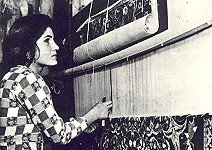 |
Persian Carpets Technical Details
A woman weaving a floral carpet, Persian carpets are usually made of wool. The most sought after wool is called "Kush". It is long, soft and silky, and is sheared in the spring from the bellies of sheep and goats. In the Hamadan and Kurdistan region, camel hair is sometimes used. Silk is frequently employed to make very finely knotted carpets. Although silk is expensive, and does not wear as well as wool, it has the advantage of not attracting moths. The dyes used to colour the wool are of the greatest importance in completing the effect and lengthening the life of Persian carpets. Innumerable raw materials have been used in the past for dying wool and dyers have always been greatly respected. Most of the traditional raw materials were of vegetable origin: roots, flowers, barks, and leaves. However, some animal products and various insects were also used. The popular belief that vegetable dyes in contrast to chemical dyes, do not fade, is unfounded. Yet, when vegetable dyes fade, they become softer and more attractive. In 1900, the government even forbade the use and import of chemical dyes; however, this law has never been strictly enforced. Persian carpets are hand-knotted. The knots used are normally Persian ( Sinneh); although in areas such as Azerbaijan and Hamadan, the Turkish (Ghiordes) knot is also used.
Professionals in the towns usually make finely knotted Persian carpets, while nomads make coarsely knotted ones. The most coarsely knotted carpets come from Kurdistan, and the finest from Kashan. There are between 65 and 330 knots per square inch in finely knotted carpets. These can come in all sizes. A nomadic weaver can tie around 8000 knots each day, and a professional weaver up to 12000 knots. The most common Persian motifs are those with flowers, linked by tendrils, and designs including animals and people; partly geometric motifs are also common. In some regions, more attention is paid to the pattern and in others to the colouring. The more distinct the pattern on the underside of the carpet, the better the quality.
Copyright shall at all times remain vested in the Author. No part of the work shall be used, reproduced, stored in a retrieval system, or transmitted in any form or by any means electronic, mechanical, photocopying, recording or otherwise, without the Author's express written consent. Copyright © 1998 K. Kianush, Art Arena |


